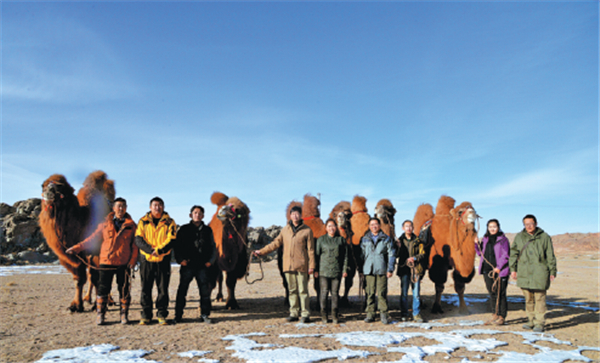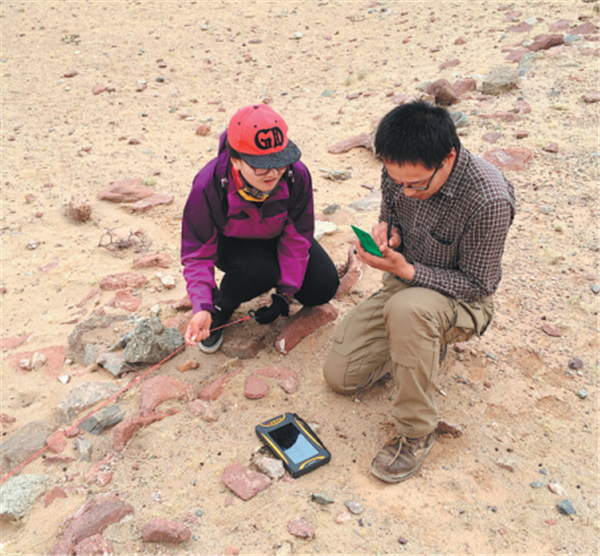Volunteers make heritage protection priority

Volunteers from the Tuofeng Cultural Heritage Protection Team pose with their camels in Alshaa Left Banner in the Inner Mongolia autonomous region. CHINA DAILY
Inner Mongolia team patrols sites in Alshaa desert to guard cultural relics.
Liu Bayar has developed a habit of traveling each month from his village in Alshaa Left Banner in the Inner Mongolia autonomous region to visit cultural sites in the desert.
He goes by camel in summer and by car, sometimes with his family, in winter.
A trip usually lasts two to three days. Whether the temperature drops to -20 C or spring sandstorms rage ferociously, Liu's plans don't change.
His trips are not for fun. Liu patrols the area to help safeguard the cultural heritage of his hometown, a mission he undertook when he joined 43 other volunteers for the duty in 2015.
Located in the western part of Inner Mongolia, Alshaa is spread across 80,000 square kilometers and has a population of 150,000. Though sparsely populated, the area has a rich cultural heritage, including ancient tombs, structures, temples and rock art sites.
There are more than 180 beacon towers from the Han Dynasty (206 BC-AD 220), 34 beacon towers from the Ming Dynasty (1368-1644), 3,578 meters of ancient city walls and more than 40 kilometers of the Great Wall.
"To meet the requirements of cultural heritage protection work and the reality that sites are scattered across mountains and remote deserts, we need help from volunteers," said Li Xiaowei, an official with the cultural heritage administration in Alshaa.
In 2015, the team of 44 volunteers, mainly consisting of local herdsmen and farmers from 8 sumu-or "villages" in Mongolian-was formed. It is known as the Tuofeng Cultural Heritage Protection Team.

Two members of the team record their findings during a routine patrol. CHINA DAILY
Based on where they live, the volunteers are divided into eight groups and assigned to patrol different sites and areas. Coats, spotlights, climbing boots, backpacks and supplies are provided. "We also conducted training and gave them lessons on cultural heritage protection," Li said.
The volunteers are now being paid for their efforts.
"The work we did was unpaid at the beginning, but I started to receive compensation last year, earning about 10,000 yuan ($1,500) for the year," Liu said.
Occasionally, Liu said he has encountered potential criminal behavior.
"Last year I came across tourists using a metal detector to look for coins. I immediately stopped them and reported the incident to the government," he said.
To enhance communication, the team has a work group on WeChat, where the volunteers upload photos and records of their patrols, and report newly discovered sites.
Sarnai, a 28-year-old team member who majored in relic authentication and repair at Chifeng University in Inner Mongolia, said she really enjoys her job overseeing beacon towers and one of the museums. She occasionally stumbles on something fascinating during patrols.
"Sometimes I get really excited when I find beautiful rock paintings. They are precious gifts from our ancestors," she said.
Sarnai patrols the sites monthly to check on damage or anything out of the ordinary, and she also works to raise awareness of cultural heritage protection among residents.
"We have to depend on local people to protect cultural relics, to improve their awareness about the heritage protection and gain their support," she said.
According to Cao Jian'en, director of Inner Mongolia's Cultural Heritage Administration, protection efforts are now part of the evaluation of the performance of officials at the regional, city and banner levels. In the past six years, the group has teamed up with police to crack rings of tomb robbers and has successfully curbed illegal oil and mineral exploration activities.
Love of their hometown and passion for cultural relics are both characteristics shared by the volunteers. In June, members were honored as the country's "most beautiful guardians" by the National Cultural Heritage Administration. It was the only group to win the title among a total of 20 individual recipients nationwide.



 Print
Print Mail
Mail





